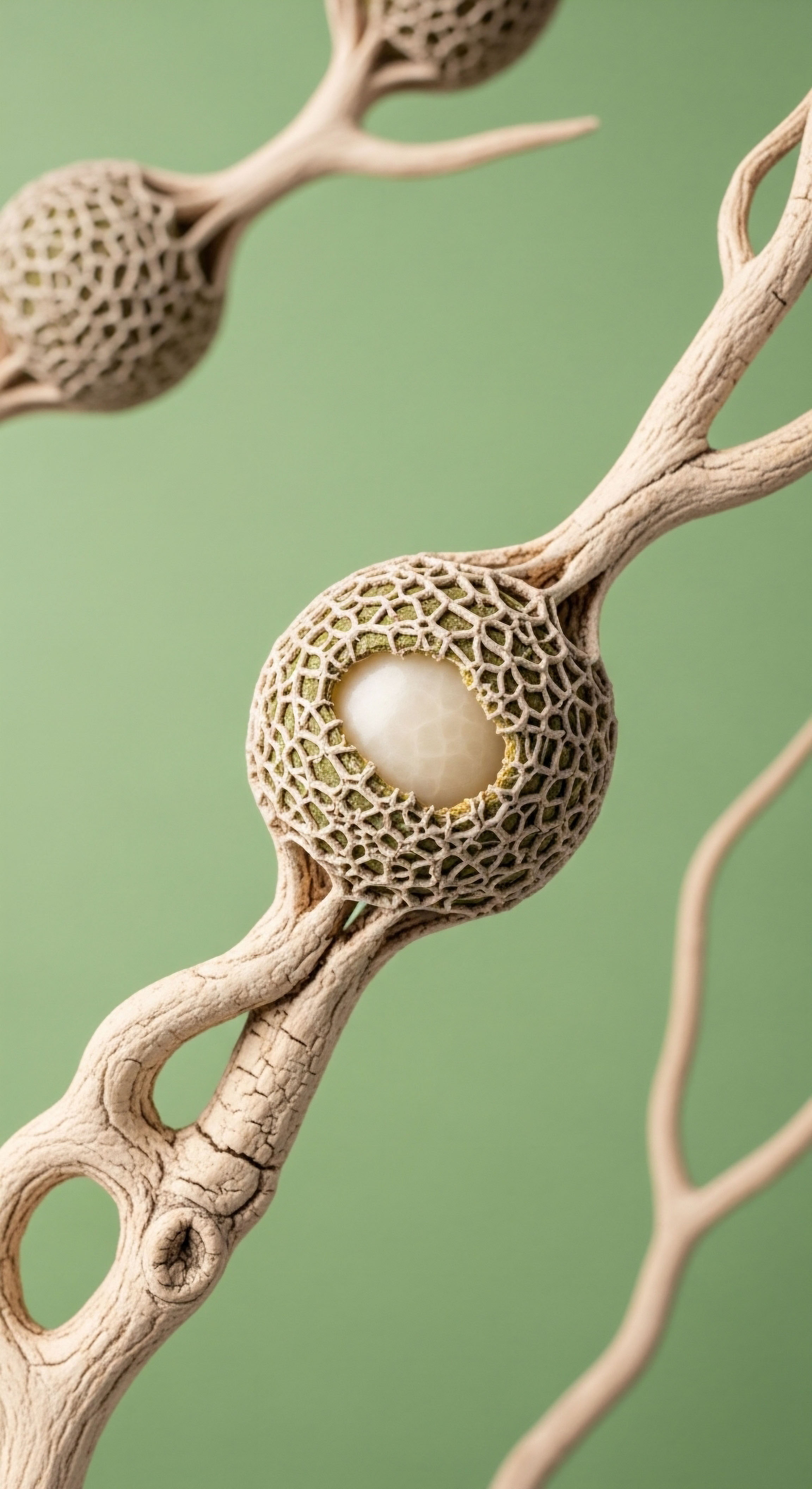

Fundamentals
You feel it before you can name it. A subtle but persistent decline in your energy, a change in the way your body holds weight, a mental fog that clouds your focus. These experiences are valid and deeply personal. They are also biological.
Your body is a finely tuned system of communication, and the language it uses is biochemical. The messengers in this system, the molecules that carry instructions from one part of your body to another, are hormones. When these signals become faint, crossed, or diminished, the entire system begins to operate at a deficit. Understanding this internal communication network is the first step toward recalibrating it.
The sensation of vitality, mental clarity, and physical strength is a direct reflection of hormonal balance. These feelings are the perceptible result of countless microscopic interactions occurring every second. Long-term endocrine support is a process of restoring the integrity of these molecular signals.
It is a methodical approach to identifying which messages are failing and providing the necessary support to ensure they are sent, received, and acted upon correctly. This process begins with understanding the body’s primary control center for hormonal regulation.

The Central Command System
Your body’s hormonal production is governed by a sophisticated chain of command known as the Hypothalamic-Pituitary-Gonadal (HPG) axis. Think of it as a corporate hierarchy for your endocrine system. The hypothalamus, a small region at the base of your brain, acts as the chief executive officer. It continuously monitors your body’s status and sends out executive orders. These orders come in the form of Gonadotropin-Releasing Hormone (GnRH).
The pituitary gland, located just below the hypothalamus, is the senior management. It receives the GnRH signal and, in response, dispatches its own set of instructions to the rest of the body. These instructions are two key hormones ∞ Luteinizing Hormone (LH) and Follicle-Stimulating Hormone (FSH).
LH and FSH travel through the bloodstream to the production centers of the body ∞ the gonads (the testes in men and the ovaries in women). The gonads are the production floor, responsible for manufacturing the final products ∞ testosterone and estrogen. This entire cascade is a delicate feedback loop.
When levels of testosterone or estrogen are sufficient, they send a signal back up to the hypothalamus and pituitary to slow down production. When levels are low, the absence of this feedback signal prompts the hypothalamus to start the process all over again. Age, stress, and environmental factors can disrupt this communication at any point along the chain, leading to the symptoms you experience.
Your lived experience of wellness is a direct output of your body’s internal hormonal communication network.

Key Messengers and Their Roles
While the endocrine system involves numerous hormones, a few key players are central to the vitality and function that often diminish with age. Understanding their roles provides a clear picture of what endocrine support aims to restore.
- Testosterone This hormone is present in both men and women, although in different amounts. In men, it is the primary driver of muscle mass, bone density, libido, and red blood cell production. It also has profound effects on mood, motivation, and cognitive function. In women, testosterone contributes to libido, bone health, and the maintenance of lean muscle mass. Its decline is often associated with fatigue and a loss of physical resilience.
- Estrogen In women, estrogen is the primary female sex hormone, responsible for regulating the menstrual cycle and supporting reproductive health. It also plays a critical role in maintaining bone density, skin elasticity, and cardiovascular health. In men, a small amount of estrogen is necessary for modulating libido, erectile function, and sperm production. The balance between testosterone and estrogen is vital in both sexes.
- Progesterone Primarily known as a female hormone, progesterone prepares the uterus for pregnancy and helps regulate the menstrual cycle. Its calming effects on the nervous system also promote sleep and can buffer the effects of estrogen. Its decline during perimenopause can contribute to sleep disturbances and mood swings.
- Growth Hormone (GH) Produced by the pituitary gland, GH is essential for growth during childhood and adolescence. In adults, it shifts to a role of maintenance and repair. It helps regulate body composition by promoting muscle growth and fat breakdown, supports bone density, and aids in cellular repair. The body’s production of GH naturally declines with age, a process that can be accelerated by poor sleep and lifestyle factors.
When we talk about endocrine support, we are talking about ensuring these molecular messengers are present in the right amounts and are able to effectively deliver their instructions. This is the biological foundation of reclaiming the feeling of being fully functional and present in your own life.


Intermediate
Advancing from a conceptual understanding of hormonal communication to the application of clinical protocols requires a shift in focus. Here, we examine the specific tools used to recalibrate the endocrine system and the biochemical logic behind their use.
These protocols are designed to directly address the points of failure in the body’s signaling cascades, whether by supplying a diminished hormone, blocking an unwanted conversion, or stimulating the body’s own production machinery. Each intervention is a precise, targeted action intended to restore a specific biological function.
The core principle of these therapies is to work with the body’s existing pathways. Hormonal optimization protocols are a form of biochemical recalibration, providing the necessary inputs to guide the system back toward its intended state of equilibrium. This involves a sophisticated understanding of how these hormones are synthesized, how they interact with one another, and how they are ultimately cleared from the body.

Testosterone Optimization Protocols a Comparative Look
While both men and women can experience the consequences of low testosterone, the therapeutic approaches are tailored to their distinct physiological needs. The goal is always to restore hormonal balance, which means accounting for the different roles and concentrations of sex hormones in each sex.

Male Hormonal Optimization
For men experiencing the clinical symptoms of hypogonadism, the standard protocol involves more than just administering testosterone. A comprehensive approach addresses the entire HPG axis to ensure safe and sustainable results. A typical protocol includes:
- Testosterone Cypionate This is a bioidentical form of testosterone attached to a slow-releasing ester molecule. Administered via weekly intramuscular or subcutaneous injection, it provides a steady, predictable level of testosterone in the bloodstream, mimicking the body’s natural rhythm more closely than other delivery methods. This stability is key to avoiding the emotional and physical fluctuations that can come with less consistent dosing.
- Anastrozole Testosterone can be converted into estradiol (a potent form of estrogen) by an enzyme called aromatase. While men need some estrogen, excessive conversion can lead to side effects such as water retention, gynecomastia, and moodiness. Anastrozole is an aromatase inhibitor, a compound that selectively blocks this enzyme. Its inclusion in a protocol is a proactive measure to maintain the proper testosterone-to-estrogen ratio, a critical factor for both efficacy and safety.
- Gonadorelin Administering external testosterone can suppress the HPG axis, as the hypothalamus and pituitary detect sufficient levels and halt their own signaling (LH and FSH production). This can lead to testicular atrophy and a shutdown of natural testosterone production. Gonadorelin is a peptide that mimics the body’s own GnRH. By administering small doses, it directly signals the pituitary to continue producing LH and FSH, thereby maintaining natural testicular function and preserving fertility.

Female Hormonal Optimization
For women, particularly during the perimenopausal and postmenopausal transitions, hormonal therapy is about restoring a complex interplay of hormones. The approach is often more nuanced, with lower doses and a different set of therapeutic goals.
A low dose of testosterone can be highly effective for women in addressing symptoms like low libido, persistent fatigue, and difficulty maintaining muscle mass. The dosages are a fraction of what is used for men, typically delivered via weekly subcutaneous injection to ensure precision and control.
Progesterone is another key component, particularly for women who still have a uterus, as it protects the uterine lining. Its calming neurological effects also aid with sleep and anxiety. Anastrozole may be used judiciously in women if there are signs of excess estrogen, though this is less common than in male protocols. The aim is to restore the delicate symphony of hormones, not just elevate one.
| Component | Male Protocol Focus | Female Protocol Focus |
|---|---|---|
| Primary Hormone | Testosterone Cypionate (e.g. 100-200mg/week) | Testosterone Cypionate (e.g. 10-20 units/week) |
| Administration | Intramuscular or Subcutaneous Injection | Subcutaneous Injection |
| Estrogen Management | Anastrozole to block aromatization | Often managed through dose adjustment; Anastrozole used selectively |
| HPG Axis Support | Gonadorelin to maintain natural LH/FSH production | Less common, as endogenous production is already declining significantly in menopause |
| Additional Support | Enclomiphene may be used to boost LH/FSH | Progesterone is frequently included for uterine health and symptom control |

What Is the Role of Peptide Therapy in Endocrine Support?
Peptide therapies represent a different strategy for endocrine support. These protocols use specific chains of amino acids, called peptides, to act as highly targeted signaling molecules. They do not replace a hormone directly. Instead, they stimulate the body’s own glands to produce and release hormones. This approach is particularly useful for supporting the Growth Hormone axis.
Peptide therapies function as precise biological prompts, encouraging the body to resume its own natural hormone production.
The most common growth hormone peptides work by stimulating the pituitary gland. For instance:
- Sermorelin A peptide that mimics Growth Hormone-Releasing Hormone (GHRH), directly telling the pituitary to release GH.
- Ipamorelin / CJC-1295 This combination provides a powerful synergistic effect. CJC-1295 is a GHRH analog that provides a steady signal, while Ipamorelin is a ghrelin mimetic that also stimulates a pulse of GH release from the pituitary. Together, they create a strong and sustained elevation in the body’s own GH levels.
This approach has a built-in safety mechanism. Because the peptides only stimulate the pituitary, the gland is still subject to the body’s negative feedback loops (like the hormone somatostatin), which prevents the runaway production of GH. The result is an increase in GH that remains within a physiological, youthful range, leading to benefits in body composition, sleep quality, and tissue repair without the risks associated with administering supraphysiological doses of synthetic HGH.


Academic
A sophisticated analysis of long-term endocrine support requires an examination of the molecular and cellular mechanisms that are altered by these interventions. The clinical outcomes observed, such as changes in body composition, mood, and metabolic health, are the macroscopic manifestations of profound shifts in biochemical pathways. At this level, we are investigating how hormonal signals, once restored, interact with cellular receptors to initiate cascades of gene transcription and protein synthesis that fundamentally reshape human physiology over time.
The primary focus of this academic exploration is the constellation of pathways affected by the restoration of optimal androgen levels through Testosterone Replacement Therapy (TRT). Testosterone’s influence extends far beyond its role in reproductive health; it is a master metabolic regulator.
Its long-term administration in hypogonadal individuals initiates a series of interconnected adjustments in glucose metabolism, lipid profiles, inflammatory signaling, and nitrogen balance. These adjustments are not isolated events but a coordinated biological response to the reintroduction of a critical anabolic and metabolic signal.

Androgen Receptor Activation and Gene Transcription
The biochemical journey of testosterone begins when it binds to the Androgen Receptor (AR), a protein located in the cytoplasm of target cells throughout the body, including muscle, fat, bone, and brain tissue. This binding event causes a conformational change in the AR, activating it and causing it to translocate into the cell nucleus.
Inside the nucleus, the hormone-receptor complex acts as a transcription factor. It binds to specific DNA sequences known as Androgen Response Elements (AREs) located in the promoter regions of target genes.
This binding initiates the transcription of dozens of genes, leading to the synthesis of new proteins. This genomic action is the source of testosterone’s most well-known effects:
- In Muscle Cells (Myocytes) AR activation upregulates the transcription of genes involved in protein synthesis, such as those for actin and myosin. It also increases the uptake of amino acids and promotes the differentiation of satellite cells, which are muscle stem cells, leading to muscle fiber hypertrophy. This is the direct mechanism behind the observed increase in lean body mass.
- In Fat Cells (Adipocytes) Testosterone’s effect on adipose tissue is multifaceted. It appears to promote the differentiation of pluripotent stem cells into the muscle lineage rather than the fat lineage. It also increases the density of beta-adrenergic receptors on adipocytes, enhancing the cell’s sensitivity to catecholamines (like adrenaline) and thereby promoting lipolysis, the breakdown of stored fat. This is particularly effective in reducing visceral adipose tissue, the metabolically active fat stored around the organs.

How Does Endocrine Support Affect Metabolic Homeostasis?
The most significant long-term impact of TRT is arguably on metabolic homeostasis, particularly insulin sensitivity and lipid metabolism. There is a well-documented bidirectional relationship between low testosterone and metabolic syndrome. Restoring testosterone levels can interrupt this cycle through several key pathways.
A meta-analysis of studies on men with type 2 diabetes or metabolic syndrome found that TRT consistently improves key metabolic markers. The therapy was shown to significantly reduce HbA1c, a measure of long-term blood sugar control, and HOMA-IR, an index of insulin resistance.
This improvement in glycemic control is driven by several factors. The increase in lean muscle mass creates a larger reservoir for glucose disposal, as muscle tissue is the primary site of insulin-mediated glucose uptake. Furthermore, testosterone appears to directly influence the insulin signaling pathway within cells, enhancing the efficiency of glucose transport.
The restoration of testosterone directly recalibrates the body’s glucose and lipid processing machinery at a cellular level.
The impact on lipid profiles is also significant. Multiple studies have demonstrated that long-term TRT can lead to a reduction in total cholesterol, LDL cholesterol (“bad” cholesterol), and triglycerides. While the effect on HDL cholesterol (“good” cholesterol) can be variable, the overall shift is toward a less atherogenic lipid profile. This is achieved through the upregulation of enzymes involved in lipid metabolism and the clearance of lipoproteins from the blood.
| Biochemical Marker | Observed Change | Underlying Mechanism | Clinical Significance |
|---|---|---|---|
| Hemoglobin A1c (HbA1c) | Decrease | Improved insulin sensitivity and increased muscle mass for glucose disposal. | Improved long-term glycemic control. |
| HOMA-IR | Decrease | Enhanced insulin signaling pathway function. | Reduction in insulin resistance. |
| Visceral Adipose Tissue | Decrease | Increased lipolysis and preferential differentiation of stem cells away from adipocyte lineage. | Reduced cardiometabolic risk. |
| Lean Body Mass | Increase | Upregulation of muscle protein synthesis via androgen receptor activation. | Increased resting metabolic rate. |
| LDL Cholesterol | Decrease | Increased expression of hepatic LDL receptors and enhanced lipid metabolism. | Reduced atherogenic potential. |
| Triglycerides | Decrease | Improved insulin sensitivity reduces hepatic triglyceride synthesis. | Improved cardiovascular health marker. |

Influence on Inflammatory and Neurological Pathways
The influence of endocrine support extends to inflammatory and neurological systems. Chronic low-grade inflammation is a known contributor to insulin resistance and cardiovascular disease. Testosterone has anti-inflammatory properties, and its restoration has been shown to reduce levels of inflammatory cytokines like TNF-alpha and IL-6. This reduction in systemic inflammation is another pathway through which TRT contributes to improved metabolic health.
In the central nervous system, androgen receptors are widely distributed in areas of the brain associated with mood, memory, and cognition. The subjective improvements in mental clarity and well-being reported by individuals on long-term therapy are not merely psychological. They are rooted in the modulation of neurotransmitter systems and the neuroprotective effects of testosterone.
This includes influencing the dopaminergic system, which is tied to motivation and reward, and promoting neuronal survival and plasticity. The comprehensive effect of long-term endocrine support is a systemic recalibration that touches nearly every major biochemical pathway in the human body, restoring function from the molecular level upwards.

References
- Fui, Mark Ng, et al. “Testosterone effects on the brain, mood, and cognition ∞ a narrative review.” The Journal of Clinical Endocrinology & Metabolism 109.4 (2024) ∞ 895-910.
- Corona, Giovanni, et al. “Metabolic effects of testosterone replacement therapy in patients with type 2 diabetes mellitus or metabolic syndrome ∞ a meta-analysis.” International journal of endocrinology 2020 (2020).
- Saad, Farid, et al. “Effects of testosterone on metabolic syndrome components.” Best practice & research Clinical endocrinology & metabolism 23.3 (2009) ∞ 315-333.
- Al-Kuraishy, Hayder M. et al. “Testosterone and metabolic syndrome ∞ The link between testosterone and insulin resistance.” Journal of Pakistan Medical Association 70.3 (2020) ∞ 508-513.
- Traish, Abdulmaged M. “Testosterone and weight loss ∞ the evidence.” Current opinion in endocrinology, diabetes, and obesity 21.5 (2014) ∞ 313-322.

Reflection

Charting Your Own Biological Course
The information presented here offers a map of the intricate biological landscape within you. It details the communication networks, the molecular signals, and the clinical strategies designed to restore function to this complex system. This knowledge provides a powerful framework for understanding the connection between how you feel and what is happening at a cellular level. It transforms abstract symptoms into tangible, addressable biological events. The purpose of this map is to equip you for your own personal health investigation.
Your journey is unique. The specific balance of your internal chemistry, your genetic predispositions, and your life’s experiences create a singular context. The path toward sustained vitality involves using this foundational knowledge as a starting point, a way to ask more informed questions and to engage with healthcare professionals as a partner in your own recalibration.
The ultimate goal is to move from a state of reacting to symptoms to a state of proactively managing your own biological system, armed with a deep and empowering understanding of how it works.



